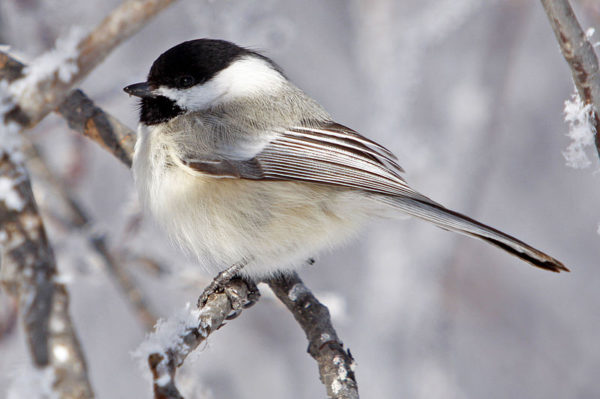Information About The Bird
Seen/Heard at
Decorah, Decorah North, Great Spirit Bluff
Diet
Black-capped Chickadees glean for food in the foliage of trees, shrubs, and bushes. During the summer, Black-capped Chickadees eat large numbers of invertebrates, including caterpillars, spiders, small snails, slugs, and centipedes. They also eat fruit, including blackberries, honeysuckle berries, and blueberries, and come to feeders for sunflower seeds, peanuts, peanut butter, mealworms, and suet. As invertebrates become less available in fall, winter, and early spring, chickadees forage for dried fruit and seeds, insect eggs and pupae, and scraps of meat and fat from carcasses. We’ve seen them looking for scraps of food in both of our Decorah Eagle nests!
Black-capped Chickadees cache food for future dinners year-round. They have a keen spatial memory, which helps them remember caching locations via visual cues like rocks, vegetation, and bird feeders. The size of a chickadee’s brain increases as caching ramps up in the fall and more memory is needed for information storage. You can learn more about caching here: https://www.allaboutbirds.org/where-is-that-bird-going-with-that-seed-its-caching-food-for-later/
Nesting
Black-capped Chickadees breed from early April through late July. Males and females excavate a nest cavity together. Once it is ready, the female takes over nest building. She uses coarse materials like moss and large grasses to build a nest foundation, which she lines with soft material including fur, hair, and fine grasses. Black-capped chickadees lay one to 13 white eggs speckled with reddish-brown spots, and produce one clutch a year. Females incubate eggs for 12-13 days and both parents tend young, which leave the nest 12-16 days after hatching. To learn more, visit Cornell’s website.
Citations
Bird Range Maps of North America
Ridgely, R.S., T.F. Allnutt, T. Brooks, D.K. McNicol, D.W. Mehlman, B.E. Young, and J.R. Zook. 2003.
Digital Distribution Maps of the Birds of the Western Hemisphere, version 1.0. NatureServe, Arlington, Virginia, USA. Data provided by NatureServe in collaboration with Robert Ridgely, James Zook, The Nature Conservancy – Migratory Bird Program, Conservation International – CABS, World Wildlife Fund – US, and Environment Canada – WILDSPACE.
Web Link: http://bit.ly/2ynPQ5I
Birds of North America: https://birdsna.org/Species-Account/bna/species/bkcchi/introduction
General Description
Black-capped Chickadees have grey overparts, light buffy underparts, and distinct black caps and bibs. Their grey wings are edged with white and their plump, rounded bodies give them a distinct spherical shape.
Different Black-capped Chickadee alarm calls have specific meanings, and several other species know how to decipher them. You can learn more about that here: https://www.allaboutbirds.org/look-out-the-backyard-bird-alarm-call-network/.
Migration
Black-capped Chickadees are year-round residents of Decorah. Most chickadees do not migrate: ie, travel between distinct summer and winter grounds – but they do irrupt, or travel within their range to find food. Winter chickadees may be residents or visitors, while summer chickadees are residents.
Measurements
Length: 4.7-5.9 in/12-15 cm
Wingspan: 6.3-8.3 in/16-21 cm
Weight: 0.3-0.5 oz/9-14 g
Wing Design
Elliptical. Optimized for bursts of fast, tightly controlled flight. Excellent at taking off quickly, maneuvering through branches, and avoiding predators.
| See also different: | Chickadees and Titmice, Decorah Nest, Decorah North Nest, Great Spirit Bluff |
